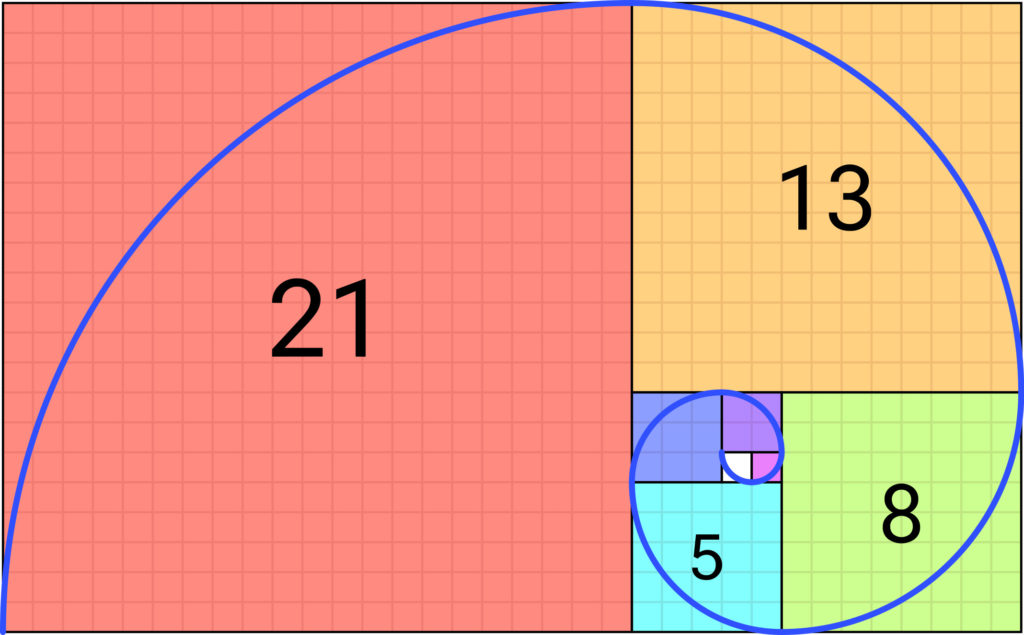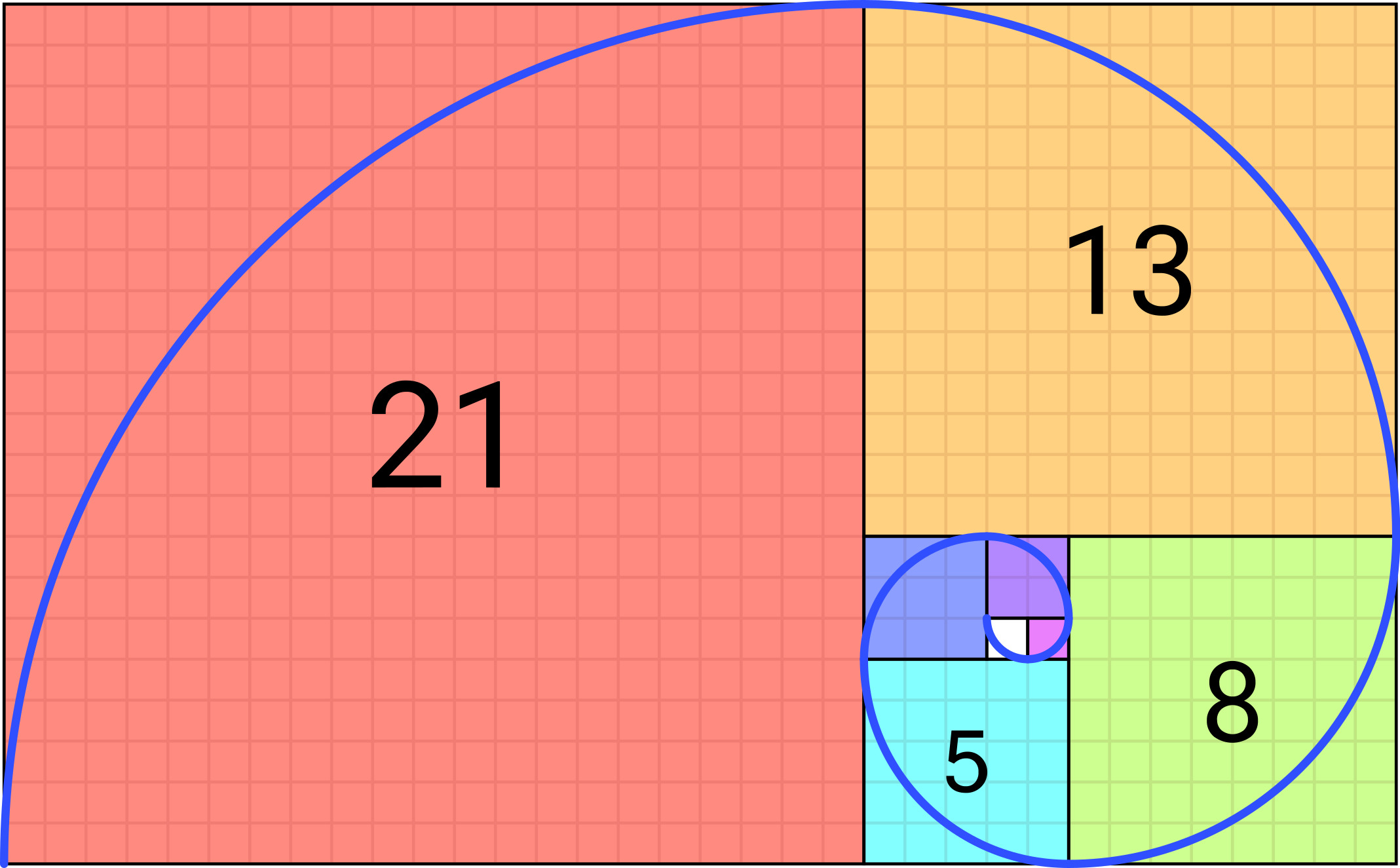
What is the golden ratio? It is 1.618.
The golden ratio appears in nature, in art, in buildings, and in logos, along with countless other places. It is called the golden ratio because anything that has these proportions is considered to be perfect. It is written as Φ, which is the Greek letter phi. You have probably seen it in pictures used to teach photography, like the one at the start of this article. There is a small box, next to it is a box that is larger, next to that is a box that is larger, and so on and so on ad infinitum. A spiral line traces through the boxes, looking something like a snail.
The golden ratio has been known about as far back as the Ancient Greeks. Euclid uses it in his Elements and Pythagoras worked with it. However, it is usually associated with Fibonacci and the sequence of numbers that we today call the Fibonacci sequence. Fibonacci was a mathematician from Pisa in the 13th century. His real name was Leonardo Bonacci. Fibonacci comes from fillius Bonacci, which means son of Bonacci.
This is the Fibonacci Sequence: 0, 1, 1, 2, 3, 5, 8, 13, 21, 34, 55, … …. Each new number is made by adding the two numbers before it. So, for example, 8 is 5 plus 3. 13 is 8 plus 5. And so on. Fibonacci used rabbits to explain it. You put a single pair of rabbits in a field. Every month, the rabbits can mate and they produce a new pair of rabbits. For this thought experiment, the rabbits never die. When the field is empty you have 0 pairs. After one month you have 1 pair. They mate in the second month, so in the second month, you still have one pair. In the third month you have two pairs. In the fourth month you have three pairs because the first pair make another pair, but the second pair don’t yet. In the fifth month you have 5 pairs because the first and second pairs make another pair, but the third pair don’t. And so on. This is the sequence.
This sequence can be found everywhere in nature. The heads of seeds, pinecones, fruits, vegetables, and flowers, all display this sequence. If you look at the seeds in the center of a sunflower, they follow the Fibonacci sequence. If you look at the petals on many flowers, they follow the Fibonacci sequence. This is not coincidence. It is the most efficient form for all of these organisms to have. If plants follow this sequence with their petals, they all have the maximum exposure to sunlight and the plant can grow the maximum number of petals.
The golden ratio comes from this Fibonacci sequence. If you divide the larger number by the smaller number, you get roughly 1.6, which is the golden ratio. Interestingly, if you divide numbers, you only get roughly the golden ratio. As the numbers you divide get larger and larger they come much closer to the golden ratio.
The golden ratio is all around us in nature, but it is also in our bodies. The ratio of the hand to the forearm is the golden ratio. The ratio of the sections on each finger are the golden ratio. The ratio of the arms and legs and torso is the golden ratio. The ratio of the length of the face to its width is the golden ratio. The distance from the top of the nose to the center of the lips and the center of the lips to the chin is the golden ratio. At least, these are all close to the golden ratio. All people are slightly different. Interestingly, the people who are closest to the golden ratio in all of these things are the people we rate as most beautiful or most handsome.
The golden ratio is also called the divine ratio, but it is worth repeating that its existence is not a coincidence. It is the most convenient ratio. If your fingers didn’t abide by the golden ratio, you couldn’t make a fist.
A lot of artists and designers have taken note of the golden ratio and they put it in pictures, photographs, or other forms of art. Architects design it into their buildings. We automatically find things more appealing when they stick to the golden ratio. Many modern designers have used the golden ratio to make logos as well. If you breakdown a lot of logos, you can see that their proportions align with the golden ratio and that makes us subconsciously like them more. And this is what I learned today.
Image By Romain – Own work, CC BY-SA 4.0, https://commons.wikimedia.org/w/index.php?curid=114415511
Sources
https://www.smorescience.com/golden-ratio-in-human-body/
https://kucdinteractive.com/croy/golden-ratio-site/humans.html
https://en.wikipedia.org/wiki/Fibonacci
https://simple.wikipedia.org/wiki/Phi
https://www.canva.com/learn/what-is-the-golden-ratio/
https://www.mathsisfun.com/numbers/fibonacci-sequence.html
https://mathcenter.oxford.emory.edu/site/math125/fibonacciRabbits/
https://www.imaginationstationtoledo.org/about/blog/the-fibonacci-sequence
https://letstalkscience.ca/educational-resources/backgrounders/fibonacci-and-golden-ratio

